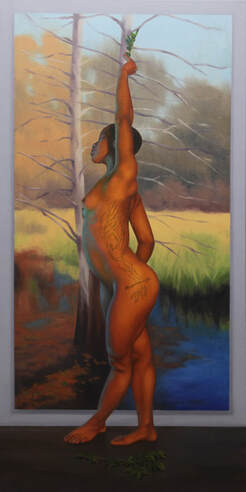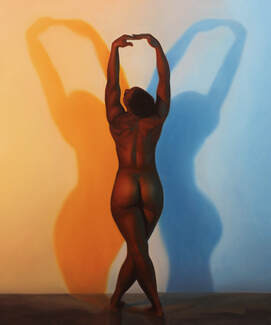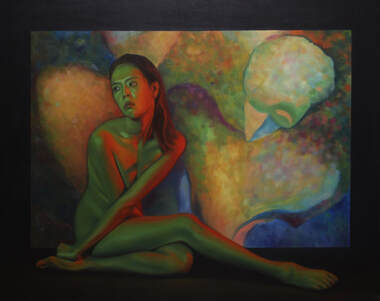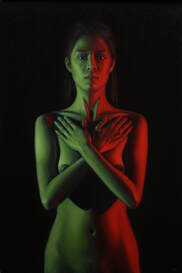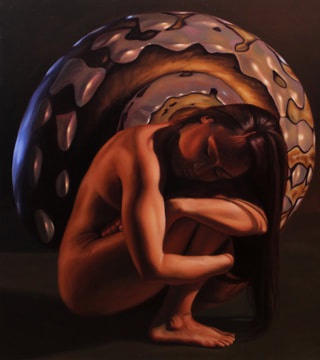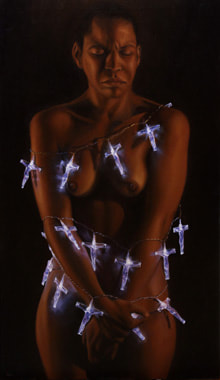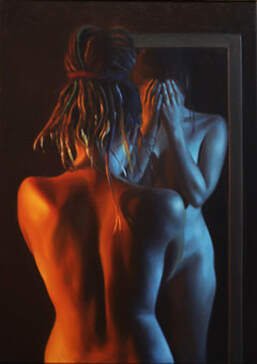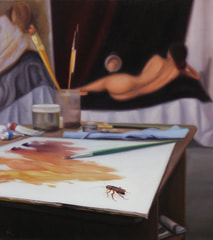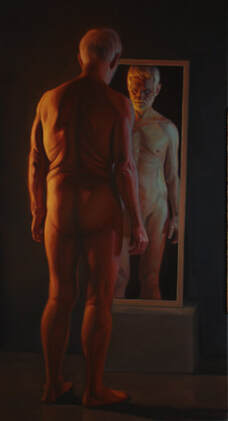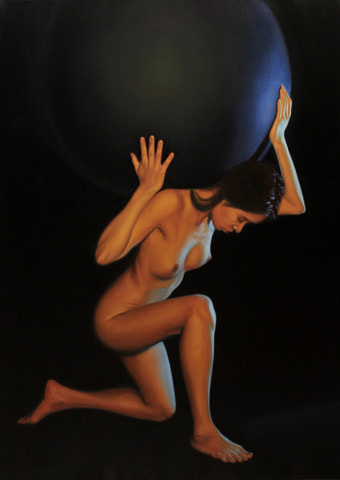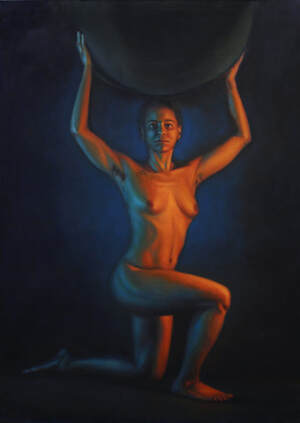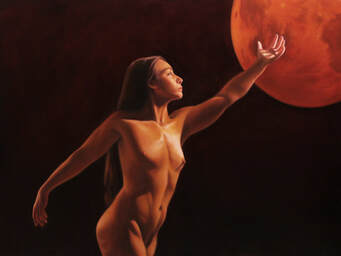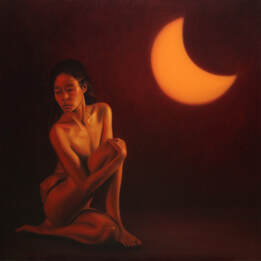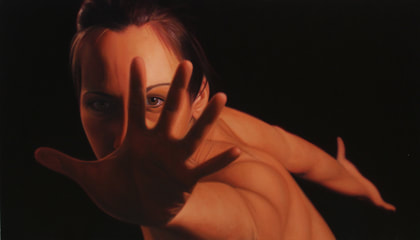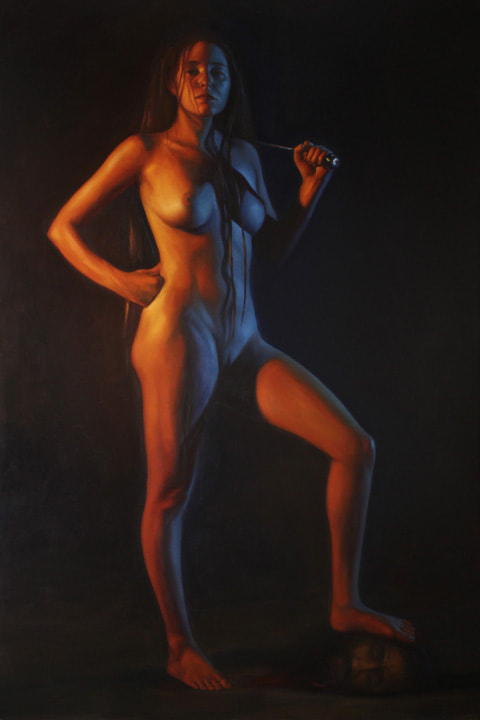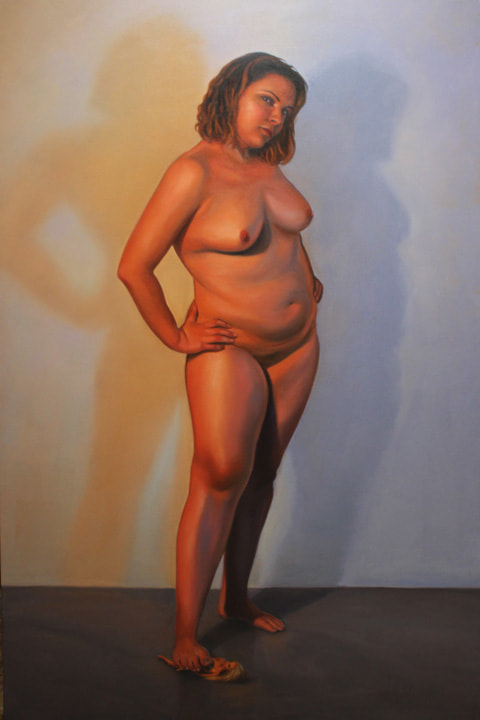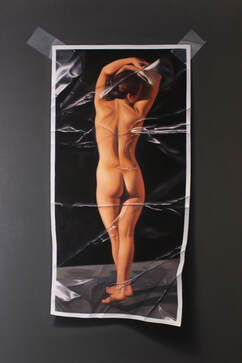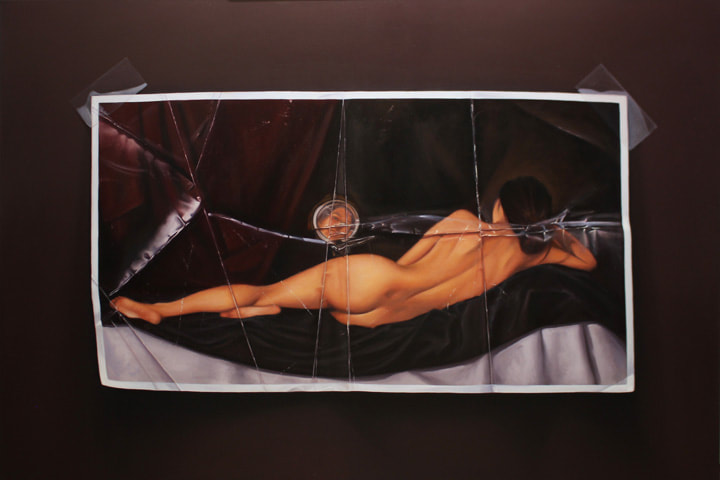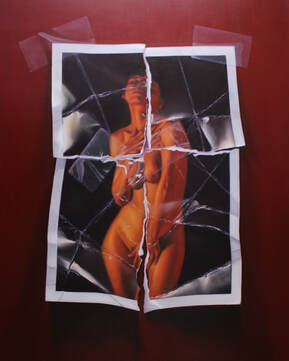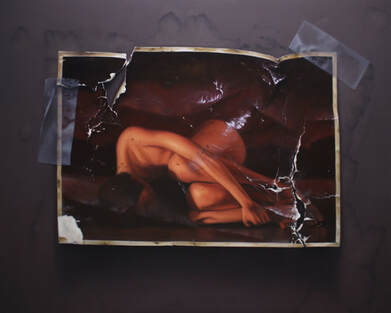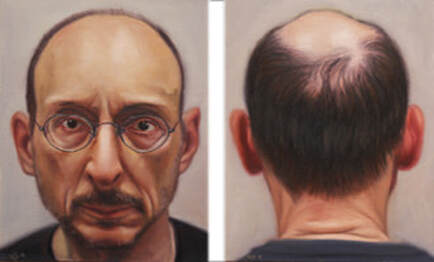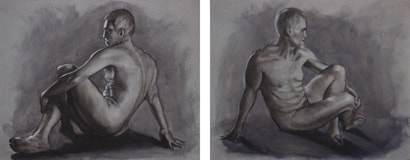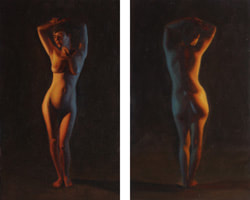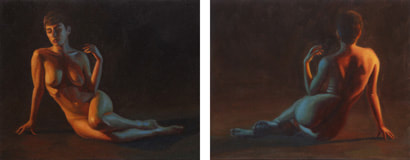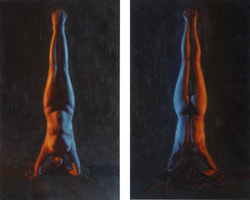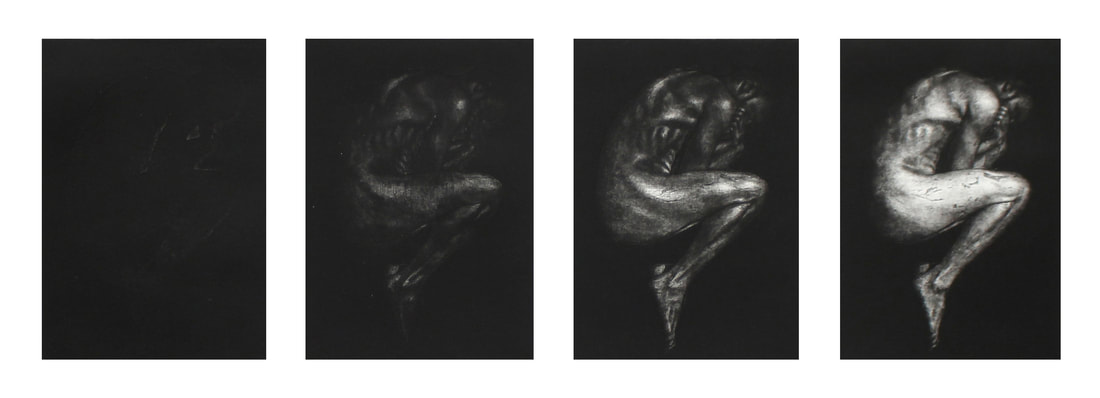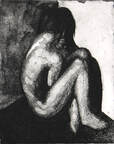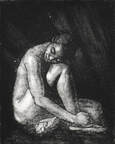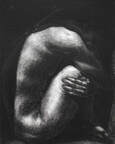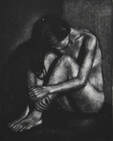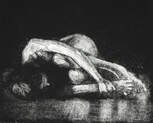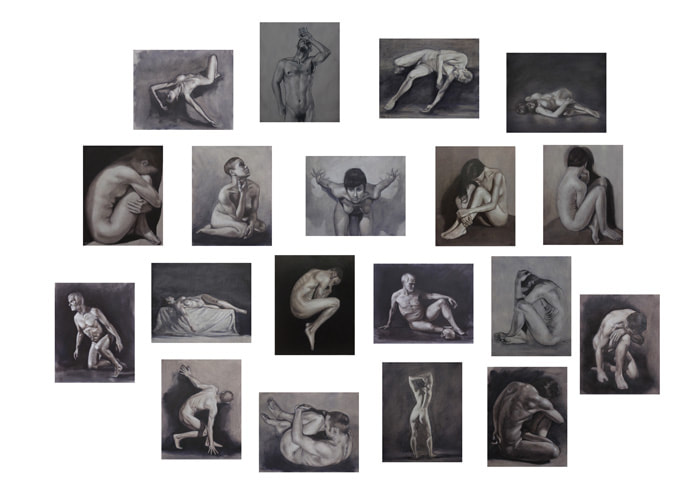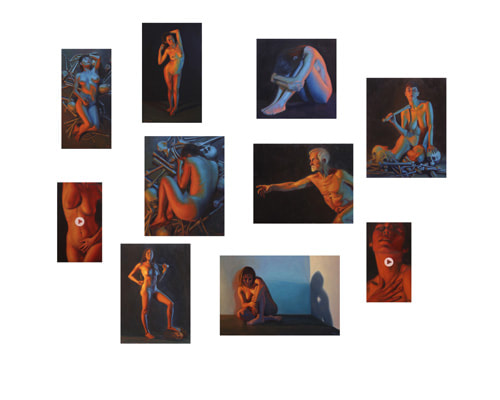THE MALE GAZE
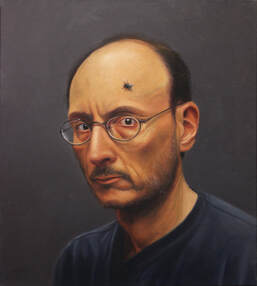 Self-Portrait with Fly, Oil on Canvas, 20x18, 2018
Self-Portrait with Fly, Oil on Canvas, 20x18, 2018
I was brutally introduced to the concept of The Male Gaze when I found my work classified under this critical category. Some research led me into this field associated with the Postmodernist movement. In brief, The Male Gaze classifies all art, but especially the female nude, as emblems of male power over the female and this form of painting exists primarily for male pleasure.
I found myself in this category solely as a result of my gender, despite these depictions often portraying women in empowered ways. Nonetheless, I find myself in need of justifying my choice of the female form both to counter this accusation and to clarify my own reasoning and motivations. In a way, I am grateful for the personal insights this has brought about.
I was introduced to figure drawing almost 25 years ago and began my first serious oils in 1996. At this time, I had begun recovery work in therapy and I found myself motivated to express loneliness and isolation in these early works. Thus came the early paintings of naked, isolated, withdrawn women in dark rooms devoid of color. In them I saw myself. I was not alone and found many others - men and women - connecting to these works.
Over the years, my relationship to the figure waxed and waned. The market taught me that female figures were more successful than male, and this led me further toward a bias for the female. This bias was reinforced by stereotypical gender associations: the female seen as the source of life, nurturing, loving, gentle; and the male as aggressive and violent. My own personal experiences of being victimized by male aggression reinforced these stereotypes.
A few years ago I returned to the figure with renewed energy. The results appeared in my previous show Death and Desire, which was split between still life and figure work. The Male Gaze is entirely figure painting.
At the outset, I had planned on several male figures, but once I settled on this title, the show coalesced into one almost entirely of women. There is one large oil of a male: The Male Gaze brings to the fore the other, hidden side of the male persona: body shame. Being the only male figure in the installation heightens the import of this statement.
As in all art, you, the viewer, can see and interpret as you wish. A manifestation of male power by a privileged straight, white male? A sensitive and thought-provoking exhibit by a vulnerable artist? Your choice. Look into The Male Gaze and remember that you are gazing into a mirror.
js, 2018
I found myself in this category solely as a result of my gender, despite these depictions often portraying women in empowered ways. Nonetheless, I find myself in need of justifying my choice of the female form both to counter this accusation and to clarify my own reasoning and motivations. In a way, I am grateful for the personal insights this has brought about.
I was introduced to figure drawing almost 25 years ago and began my first serious oils in 1996. At this time, I had begun recovery work in therapy and I found myself motivated to express loneliness and isolation in these early works. Thus came the early paintings of naked, isolated, withdrawn women in dark rooms devoid of color. In them I saw myself. I was not alone and found many others - men and women - connecting to these works.
Over the years, my relationship to the figure waxed and waned. The market taught me that female figures were more successful than male, and this led me further toward a bias for the female. This bias was reinforced by stereotypical gender associations: the female seen as the source of life, nurturing, loving, gentle; and the male as aggressive and violent. My own personal experiences of being victimized by male aggression reinforced these stereotypes.
A few years ago I returned to the figure with renewed energy. The results appeared in my previous show Death and Desire, which was split between still life and figure work. The Male Gaze is entirely figure painting.
At the outset, I had planned on several male figures, but once I settled on this title, the show coalesced into one almost entirely of women. There is one large oil of a male: The Male Gaze brings to the fore the other, hidden side of the male persona: body shame. Being the only male figure in the installation heightens the import of this statement.
As in all art, you, the viewer, can see and interpret as you wish. A manifestation of male power by a privileged straight, white male? A sensitive and thought-provoking exhibit by a vulnerable artist? Your choice. Look into The Male Gaze and remember that you are gazing into a mirror.
js, 2018
BEAUTY
Sometimes I paint just to create something beautiful. I judge this to be an innate desire in all people. I try to bring beauty into all my work and lament that much of modern art eschews beauty as a goal.
|
One of the models I worked with had a magnificent tattoo on her side (this has since changed). My usual dark background was insufficient for this piece, so I placed her in front of a bright landscape by Harold Joiner my colleague here at the gallery. It was only after its completion that I realized the connection to the mythical Daphne who turner herself into a tree to avoid the unwanted amorous advances of Apollo.
|
I began using colored lights on my models a couple of years ago and loved the effects they created. I had previously placed a model in front of a piece by Donna Perkins, who based her abstracts on the movement of dancers. A natural extension, it seemed, would be to focus on color, rather than line, which I had done previously. This time I chose Liz Conces Spencer for the artistic backdrop. I had hesitated in executing this piece because I found the figure leering over her to be quite menacing. But after the MeToo movement broke, I plunged ahead with no regrets.
|
SHAME AND ISOLATION
As in my first series of figure works, I continue to express feelings of isolation and shame in my figures, though these are now balanced by other themes.
|
When I saw this polished shell, I knew that I wanted to do this piece. I showed it to my model, a serious yoga practitioner, and told her to select an appropriate yoga pose.
Knowing I am a lapsed Catholic, a friend gave me these gaudy illuminated crucifixes. I liked the metaphor of being bound by these icons of faith and the other associations brought up by using an African American model. I am particularly happy with the pained expression on her face, which arose spontaneously during the photo shoot.
|
I am often surprised when the models I work with express feelings of insecurity and body shame. This has happened on several occasions and so this piece came about.
This piece expresses my own body shame, which is especially acute when in the presence of young, attractive models. I chose a Kafkaesque portrayal for myself.
|
The only large-scale male figure in the installation. I wanted this piece to stand out to show the other side of the Male Gaze: that of male insecurity. I had this model stare down at his own sex to heighten the impact.
THE HEROIC
These pieces stand in stark contrast to the previous ones of shame and isolation. They depict women in rightful positions of power. Note the parallels between Judith and Barbie - probably the most heroic pieces I've ever executed.
Though I started to do this as a male figure, I quickly changed my mind and decided to break tradition and use a woman. For me, these works express a current reality: that of women moving into long-overdue roles of empowerment.
I wanted to associate the moon with the female cycle. Like "Stonehenge" from my last show, this piece celebrates fertility and femininity with the blood moon drawing an obvious connotation.
This piece arose during a spontaneous session with a model. This appeared and it offers many narrative possibilities.
|
I was inspired to do this piece after a stay in Florence. While there, I drew the connection between David and Judith: both had killed and beheaded their enemies. I then chose to model Judith after the statues of David by Donatello and Michelangelo: one hand raised to the should, another on the hip and one foot on the head. Typical paintings of Judith show her clothed, but I chose to show her naked both to connect the work to David as well as to heighten her sexuality, which she had used to entrap Holofernes.
|
If there is one icon that has caused more body shame than any other it is this irresponsibly proportioned doll. This model was more than happy to crush her beneath her foot. I had hesitated to make this a large piece, but the image is an important theme of the show and so I have no regrets.
|
THE RECOVERED PHOTOGRAPH
I have been painting collaged photos for many years and added the tape illusion a few years ago. But these were always landscapes. I pondered on how I could do the same with the figures, but the collage effect didn't work. Crumpling the photograph added another narrative element. The first piece, Treasured, was pleasing so I expanded the series.
|
The first of the series, Treasured has strong narrative possibilities: why was the photo nearly destroyed? And why was it recovered in this way? The crumpling evokes images of violence. And yet it has been carefully preserved.
Here, I wanted to specifically evoke art history by having the model assume the pose of Venus in the famous painting by Velasquez. This focuses the narrative on attitudes towards the female nude. I practiced the folding the photograph a number of times and when I settled on a pattern of folds, I carried it in my pocket for several weeks to distress it.
|
This piece brings up issues of sexuality and the conflicts around desire. This is another case where I tore the photograph a number of times, settling on the cross-like tears and thus evoking religious overtones.
My tribute to the effects of Harvey. I distressed this photograph by putting it in a flower pot for several weeks, watering it diligently and waiting for it to get moldy. I added the water stains to the backboard for additional effect.
|
PANELS
While at the National Museum in Washington I saw the only Leonardo painting in North America. This portrait, typical of the era, was painted on both sides of a panel: image on front and family crest on the back. Pondering this, I thought I would do the same but instead chose to show the same image as seen from either side.
ETCHINGS
For Birth, I made prints of the plate as I developed the image from the dark aquatint. Similarly, for Death, I made prints as I destroyed the plate by sanding it down.
Etchings, Etching and Aquatint, 5x4 each, 2018
